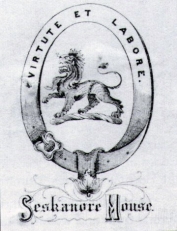Alex Watson is a researcher and genealogist, based in Glasgow, Scotland, I hope that you find this website informative, it is an ongoing project, based on the research that I started, in 2004, on behalf of my friend Patrick Joynson-Wreford, it will continue to be updated as more information becomes available.
Please get in touch if you want to ask questions or need some help, also if you have any information, stories, photographs, etc, that you want to share.
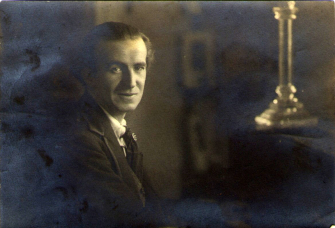
Raymond Saville Conolly de Montmorency Lecky Browne-Lecky
of Ecclesville
1881-1961
Raymond Browne-Lecky was born on 17th May 1881, the second child of Annie Henrietta Eccles and Conolly William Browne-Lecky of Aughentaine, Co. Tyrone. His elder sister, Isabella Caroline Annie Browne-Lecky, was born on 21st September 1879. She married first Captain Kenneth E. Warden, from whom she later divorced, and secondly Charles Ernest William Bland of Colsterworth House, Lincolnshire.
Raymond resided at Ecclesville House, Fintona, Co. Tyrone — the ancestral seat of his mother’s family, the Eccles's. The house, built around 1703, had passed into the Browne-Lecky line through his mother.
Known for his flamboyance and theatrical flair, Raymond was a musician, actor, and celebrated female impersonator, performing under the stage name "TIBBY". He was a notable figure within both the Irish Ascendancy and artistic circles, admired (and sometimes gossiped about) for his eccentric style. His favourite colour was mauve, and he was rarely seen without it — his personal rooms in Ecclesville were lavishly decorated in mauves and pinks, and he was often spotted locally in a two-tone green Austin 16 motorcar, dressed head to toe in his signature hue.
A letter from Augustus McClintock (brother-in-law of Raymond's cousin, Amy Eccles McClintock), written c.1896, captures a colourful scene from Raymond’s early life:
“Nell and I went to church yesterday, it was dull enough. Young Raymond was there — his hands covered with large diamond rings, big button hole, specs with gold chain, gold chain to hold his Tyrolean hat on with — altogether a terrible sight, I think it’s a pity of the boy.”
Raymond never needed to work, having inherited a comfortable income from the Eccles estate. He cultivated an artistic lifestyle, studying piano and singing, and hosting frequent private performances, particularly during the social Season in Dublin, where guests were invited to his “at homes.” At Ecclesville, he even converted an outbuilding into a theatre, where he regularly staged performances for invited audiences — often in support of charitable causes. Local dignitaries and neighbouring landowners were among the attendees, and his events raised significant funds for local and national charities.
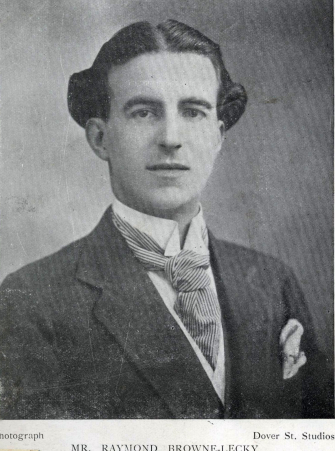
Raymond's father, Conolly William Lecky Browne, was the son of Thomas Richardson Browne Esq., of Aughentaine Castle, Co. Tyrone, and Sarah de Montmorency — daughter of Hervey Randall Saville Pratt de Montmorency of Castle Morres, Co. Kilkenny, by Rose Kearney, daughter of Rt. Rev. John Kearney, Bishop of Ossory.
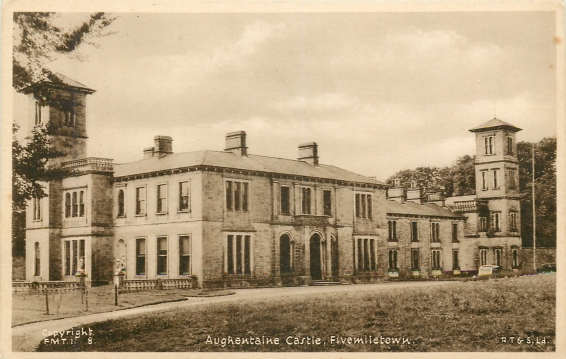
Aughentaine Castle, Co. Tyrone
Aughentaine Castle was constructed circa 1863 for Thomas Richardson Browne, Esq., of the Estate and Manor of Aughentaine and Mountstewart, to a design by the prominent Dublin architectural firm Isaac & W. R. Farrell. The structure was built using stone quarried on the estate itself.
The castle was described as consisting of a two-storey main block with an adjoining lower two-storey wing, and was distinguished by two tall Italianate campaniles of equal height positioned at either end. Architectural features included an open porch, as well as two-light and three-light windows, some round-headed, others rectangular—all contributing to a highly picturesque silhouette in the Tyrone landscape.
Following several decades in family ownership, the Aughentaine estate was sold around 1955 by Mervyn Knox-Browne, a descendant of Thomas Richardson Browne. Mervyn subsequently relocated to Perthshire, Scotland. The property was acquired by Lieutenant-Colonel John Henry Hamilton-Stubber, who demolished the original castle and, circa 1958, commissioned a neo-classical house on the site. This replacement residence was designed by The Hon. Claud Phillimore, a noted architect of English country houses.
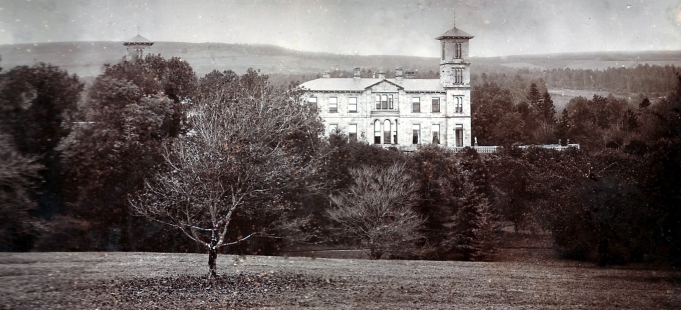
AUGHENTAINE ESTATE—ADDRESS AND PRESENTATION.
On Tuesday, the 10th instant, a meeting of the tenantry of the estate and manor of Aughentaine and Mountstewart, the property of Thomas R. Browne, Esq., D.L., J.P., took place at the Castle (Aughentaine) which is in course of erection. The object of the meeting was to present J. Hervey Browne, Esq., H.M. 12th Royal Lancers, eldest son and heir of T. R. Browne, Esq , on his attaining his majority, with a gold vase, accompanied by addresses to Mr. Browne and his son. The tenantry from all parts of this extensive estate were in attendance, and among the guests, and others present were—Thomas R. Browne, Esq., Mrs. Browne, J. Hervey Browne, Esq., and the Misses Browne, George F. Frooke, Esq., J.P, D.L , of Colebrooke, county Fermanagh; Rev. William Burnside, of Corcreery House, Rector of Magheracross; Mrs. Burnside; Rev. Aiken Irvine, Incumbent of Fivemiletown; and John Smith, Esq., Cavanakirk.
Belfast Morning News - Monday 23 February 1863.
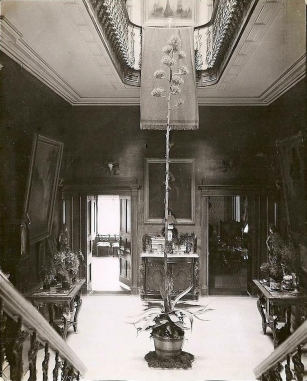
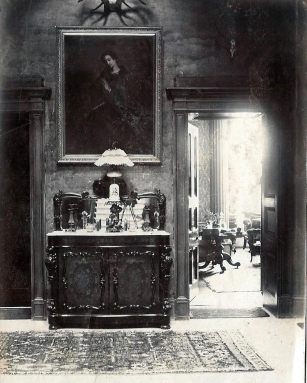
Interior photographs of Aughentaine Castle.
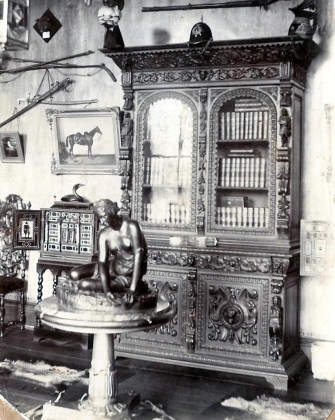
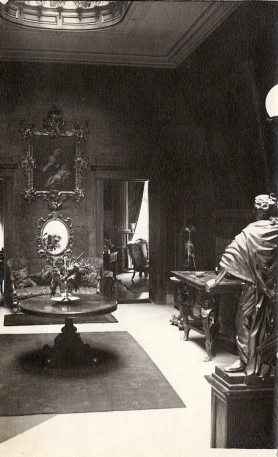
The Morres / de Montmorency Family of Castle Morres, Co. Kilkenny
In 1684, the castle, manor, town and lands of Castle Morres, Co. Kilkenny, were granted to Hervey Morres, Esq. He married Frances Butler, daughter of Pierce Butler of Barrowmount, Co. Kilkenny, and had issue:
Francis Morres (b. c.1680)
Married in 1706 to Catherine Evans, daughter of Sir William Evans of Kilcreene, Co. Kilkenny, and had issue:
-
Sir William Evans Morres, 1st Baronet
Married Margaret Haydock; died 11 October 1774, having had issue. -
Redmond Morres
Married Elizabeth Lodge, daughter of Francis Lodge of Dublin; died August 1784, having had issue. -
Hervey Morres, 1st Viscount Mountmorres (b. c.1706)
Created Baron Mountmorres on 4 May 1756, and Viscount Mountmorres on 29 June 1763.
Married (1st) 3 November 1742 to Lady Letitia Ponsonby, daughter of Brabazon Ponsonby, 1st Earl of Bessborough, and Sarah Margetson. She died 9 February 1754, having had issue:-
Hon. Letitia Morres
Married (1st) Hon. Arthur Hill Trevor, son of Arthur Hill-Trevor, 1st Viscount Dungannon, and Anne Stafford, on 27 February 1762.
Married (2nd) Sir Randal William Mac Donnell, 1st and last Marquess of Antrim, on 3 July 1774.
Died 7 December 1801, having had issue. -
Hon. Sarah Morres
Married Rev. Joseph Pratt, son of Rev. Joseph Pratt and Elizabeth Chetwood, on 28 March 1772.
Died 1831, having had issue. -
Hervey Redmond Morres, 2nd Viscount Mountmorres (b. c.1743 – d. 17/18 August 1797)
He shot himself through the head at his residence in York Street, St James’s Square, London on the night of 17–18 August 1797, having previously shown signs of mental and emotional distress. He died unmarried, and the title passed to his half-brother.
-
Hervey Morres, 1st Viscount Mountmorres, married (2nd) July 1755 to Mary Wall, daughter of William Wall and Hon. Mary Ponsonby (aunt of his first wife), and had further issue:
-
Francis Hervey Morres, 3rd Viscount Mountmorres (b. 1 September 1756 – d. 23 March 1833)
On 17 June 1815, he assumed by Royal Licence the name Francis Hervey de Montmorency.
Married Anne Reade, daughter of Joseph Reade. Had issue. -
Hon. William Mary Morres (b. 1760 – d. 1809)
Died unmarried and without male issue, by drowning.
Castle Morres
Castle Morres was rebuilt in the mid-18th century by Hervey Morres, 1st Viscount Mountmorres, to a design by Francis Bindon, one of Ireland’s most distinguished Georgian architects. The house became one of the grandest country seats in Co. Kilkenny, and a symbol of the family's elevated status.
Upon the tragic suicide of Hervey Redmond Morres, 2nd Viscount, in 1797, the peerage passed to his half-brother Francis Hervey de Montmorency, while the Castle Morres estate itself was inherited by his half-sisters, Letitia and Sarah Morres, further dividing the family’s once-unified power and property.
PRATT of Cabra Castle, Co. Cavan.
SARAH MORRES m. Rev. Joseph Pratt, son of Rev. Joseph Pratt and Elizabeth Chetwood of Cabra Castle, County Cavan, and had issue,
- Mary Pratt d. 1798.
- Letitia Pratt
- Reverend Mervyn Pratt d. 1823.
- Colonel Joseph Pratt of Cabra Castle, b. 1775, m. Jemima Roberta Tynte, daughter of Sir James Stratford Tynte, 1st and last Bt., in 1806. d. 27th Aug 1863.
- Major HARVEY RANDALL SAVILLE PRATT of Castle Morres, b. Sep 1782, d. 20th Sep 1859.
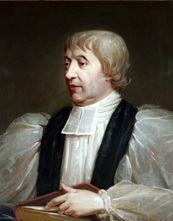
Right Rev. John Kearney, Bishop of Ossory.
HARVEY RANDALL SAVILLE PRATT, b. September 1782, m. Rose Lloyd Kearney, daughter of Rt. Rev. John Kearney, in July 1811. On the death of his father in 1831 he succeeded to the 4,840 acre Castle Morres estate of his mother's family in Co. Kilkenny, on condition that he assumed the surname and arms of de Montmorency. On 27th September 1831, his name was legally changed to Harvey Randall Saville Pratt de Montmorency by Royal Licence. He held the office of Deputy Lieutenant (D.L.) and lived at Castle Morres, Aghaviller, County Kilkenny, Ireland. He died on 20th September 1859, having had issue:-
- Elizabeth de Montmorency
- SARAH de MONTMORENCY b.c. 1818, m. Thomas Richardson Browne, of Aughentaine Castle, Co. Tyrone.
- Joseph de Montmorency
- Harvey Mervyn de Montmorency d. 22nd Sep 1899
- Letitia de Montmorency
- Rose de Montmorency
- Anne Sarah de Montmorency b. c 1812, d. 20th Feb 1890
- John Pratt de Montmorency b. c May 1815, d. 6th May 1868
- Frances de Montmorency b. c 1820, d. 1888
- Raymond de Montmorency d. 1916
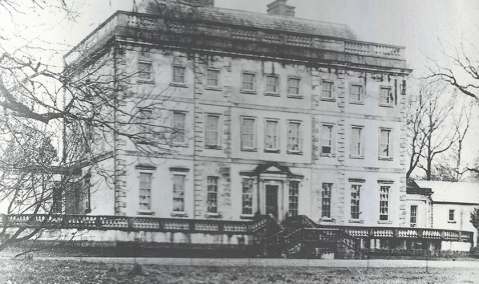
Final Ownership and Fate of Castle Morres Estate
John Pratt de Montmorency
-
Last private owner of Castle Morres, Co. Kilkenny
-
Died October 1924
= Mary de Montmorency (widow), died July 1925
Upon their deaths:
-
The Castle Morres estate was sold to the Irish Land Commission, which had been acquiring large estates under the Irish Land Acts.
-
In the early 1930s, the house was unroofed to avoid rates and fell into dereliction.
-
A demolition sale followed, and architectural features (doors, staircases, fireplaces, stonework) were dispersed — many now integrated into houses around Ireland.
-
The ruins of the house were finally demolished in 1978.
Present Day:
-
The grounds of Castle Morres have been absorbed into the Coillte forestry estate, with approximately 2,000 acres of forested land now surrounding the area once occupied by the estate.
I. BROWNE of Cumber House, Co. Londonderry and Aughentaine Castle, Co. Tyrone
1. John Hamilton Browne
of Cumber House, Co. Londonderry and Aughentaine Castle, Co. Tyrone
Married Jane Matilda Lecky (b. c.1782, d. 1855), daughter of William Lecky MP of Castlefin, Co. Donegal and Hannah McCausland, of Fruithill (Drenagh), Co. Londonderry.
They had issue including:
2. Thomas Richardson Browne
of Cumber House and Aughentaine Castle
Married Sarah de Montmorency in 1839, daughter of Major Harvey Randall Saville Pratt (later de Montmorency) of Castle Morres and Rose Lloyd Kearney.
He died 29 May 1882; she died 1 Mar 1889.
Issue:
2.1. Raymond Saville Browne (-Lecky)
-
By Royal Licence 4 Mar 1871, assumed the name Lecky in addition to and after that of Browne.
-
Died dsp (without issue) on 20 Aug 1873.
2.2. Conolly William Lecky Browne
-
Married 28 Nov 1878 Anna (Annie) Henrietta Eccles, daughter of Charles Eccles JP DL of Ecclesville and Isabella Blake.
-
He died 19 Jan 1924; she died 8 Jul 1922.
-
Had issue (not detailed here; let me know if you’d like them added).
2.3. Rose Sarah Browne
-
Married Major Robert Conway Dobbs Ellis, of Abbeyfeale, Co. Limerick.
-
Had issue.
2.4. Caroline Frances Browne
-
Married 23 May 1871 John Stuart Eccles DL, son of Charles Eccles JP DL of Ecclesville and Isabella Blake.
-
He died 24 Apr 1886; she died 12 Feb 1887.
-
Had issue.
2.5. Matilda Theodosia Browne
-
Married 11 Dec 1883 Charles Edward Eccles, Captain, Donegal Militia Artillery
-
Born 20 Oct 1850, son of Charles Eccles JP DL and Isabella Blake.
-
-
dsp (without issue).
2.6. Lt.-Col. John Hervey Knox-Browne
-
married Louisa Elizabeth Knox-Gore, daughter of Sir Francis Arthur Knox-Gore, 1st Bt., on 19 December 1867.1 He died on 3 April 1927 at age 86
-
Had issue.
-
II. LECKY and McCAUSLAND Ancestry (Maternal Line of Browne Family)
1. William Lecky MP, of Castlefin, Co. Donegal
Married Hannah McCausland (b. 3 Oct 1751, d. 26 Aug 1826)
-
Daughter of Conolly McCausland of Fruithill (Drenagh), Co. Londonderry.
Issue: -
Jane Matilda Lecky (b. c.1782, d. 1855), married John Hamilton Browne
2. Conolly McCausland, of Fruithill (Drenagh), Newtownlimavady, Co. Londonderry
-
Born 21 Nov 1713; died 27 Jun 1794.
-
Married Elizabeth Gage, daughter of Thomas Gage of Bellarena, Magilligan, and Sarah Hodgson.
Issue: -
Hannah McCausland, b. 3 Oct 1751, d. 26 Aug 1826, m. William Lecky MP.
3. Col. Robert McCausland
-
Married in 1709 Hannah Moore.
-
Two possible identities for Hannah Moore:
-
Daughter of William Moore of Garvey, and widow of James Hamilton Jr. of Strabane,
-
According to Conolly McCausland of Drenagh (modern source): daughter of William Conolly, Speaker of the Irish House of Commons.
-
This second identification is significant and explains the inheritance of estates and continued use of the Conolly name in the McCausland family and explains why he left the lands of Limavady to her husband in his will:-
-
-
'I likewise give and bequeath to my said Nephew (Wm Conolly Esq.) his heirs Executors and Administrators respectively all my Leases and Terms for years or lives except only the Lease for years which I hold from the See of Derry in the County of Londonderry which lease I do hereby give and bequeath to my Agent Robert McCausland Esq. his executors and administrators as an Acknowledgement for the faithful service he has done me.'
Will of William Conolly of Celbridge, County Kildare, dated 18th Oct 1729.
The National Archives. PROB 11/636/185.
*In 1697 William Conolly purchased the Limavady estate from the descendants of Sir Thomas Phillips, who had been granted it at the time of the Plantation.
Conolly William Lecky Browne, son of Thomas Richardson Browne of Aughentaine Castle, County Tyrone, and Sarah de Montmorency, was the eventual heir to his grand-uncle, Conolly McCausland Lecky of County Londonderry, who was the brother of his grandmother, Jane Matilda Lecky. In compliance with the terms of his grand-uncle’s will, he assumed the additional surname Lecky after that of Browne, by Royal Licence dated 14 July 1874.
Conolly McCausland Lecky had amassed a considerable estate in County Londonderry, deriving substantial income from rentals. He married Anne Harvey, daughter of John Harvey, Esq. of Bargy Castle, County Wexford. The couple had no children. He died on 17 July 1857, leaving a detailed will disposing of his property as follows:
'By his will dated 29 January 1856 Conolly McCausland Lecky devised all his estates real freehold and personal including the several lands comprising this Estate unto the Reverend Robert Gage as Trustee of his will
- UPON TRUST out of the rents and profits to pay the outgoings and to pay the outgoings and to pay the residue to Testator's wife for her life and after her death
- UPON TRUST to apply the residue to the use of Testator's nephew William Lecky Browne for his life and after his death TO the use of Raymond Saville Browne second son of Testator's nephew Thomas Richardson Browne (except £100 per annum which he directed to be paid to the use of Conolly William Lecky Browne third son of Testator's nephew Thomas Richardson Browne for the life of the said Conolly William Lecky Browne)
- DECLARATION that should the aforesaid Raymond Saville Browne succeed [sic] to the Estate of Aughentaine in the County of Tyrone or become entitled to same the devise therein made was to become null and void and the residue should be paid to the aforesaid Conolly William Lecky Browne
- AND in case the Testator should succeed to the Aughentaine Estate then the said devise should also be null and void
- BUT in case no succession should take place of either of them the said Raymond Saville Browne as aforesaid should have the devise as made by the Testator for his life
- AND AFTER HIS DECEASED [sic] the said Trustee was to stand seized and possessed of the property devised by the said will and to apply the residue of the rents and profits into and to the use of the first and every other son successively of the said Raymond Saville Browne according to priority of birth and heirs male of the body of each such son respectively and successively
- AND in default of such issue or in case the said Raymond Saville Browne should succeed to the said Aughentaine Estate
- THEN to pay the residue unto and to the use of the said William Lecky Browne for his life
- AND FROM AND AFTER HIS DECEASE then unto and to the use of the first and other sons successively of the said Conolly William Lecky Browne according to priority of birth and the heirs male of the body of each and such sons respectively and successively
- AND in default of such issue or in case the said Conolly William Lecky Browne should succeed to the said Aughentaine Estate
- THEN the said Revd. Robert Gage was to stand seized and possessed of the said properties to the uses therein mentioned.
- 1857 July 17. The Testator died
- 1857 October 24. Probate of the said Will was granted to Mrs Anne Lecky, William Lecky Browne and Thomas Richardson Browne the Executors therein named.
- 1862 May 29. The said William Lecky Browne died without issue.
- 1865 February 14. The said Anne Lecky, widow of the said Conolly McCausland Lecky, died.
- 1873 August 20. The said Raymond Saville Browne died a bachelor.
- 1874 May 12. By Deed Poll the said Conolly William Lecky Browne assumed the name of Lecky and attained the age of twenty one years on the 13th. July 1873 and under the limitations of the said Will entered into possession of the lands and hereditaments devised by the said Will and the receipt of the rents and profits thereof.
- 1924 January 19. The said Conolly William Lecky Browne Lecky died whereupon the lands granted by the lastly abstracted Indenture became in default of any such appointment as aforesaid vested in the said Raymond Saville Conolly de Montmorency Lecky Browne Lecky absolutely'.
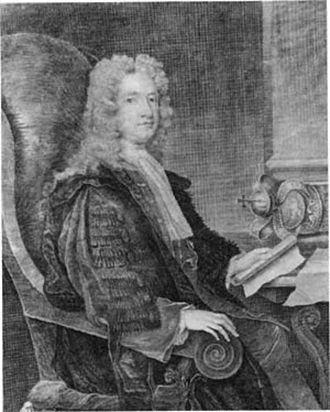
William Conolly.
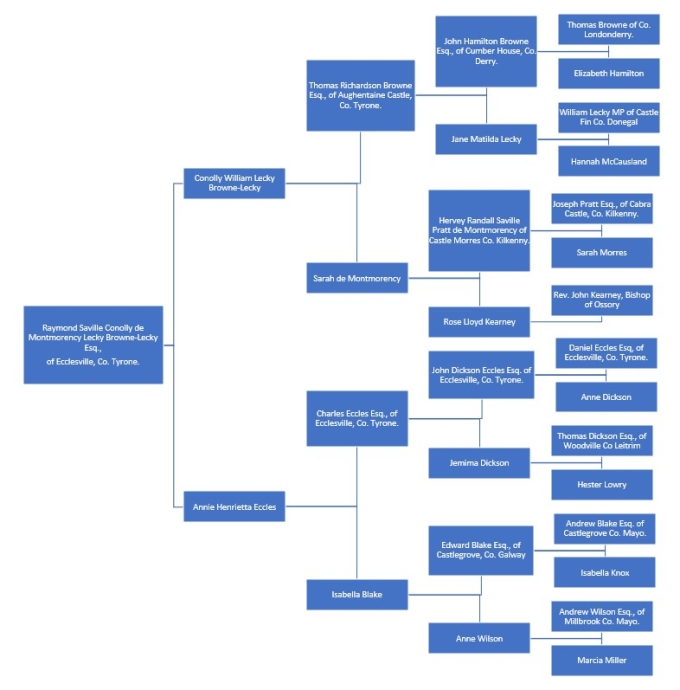
Raymond Saville Conolly de Montmorency Lecky Browne-Lecky
of Ecclesville, County Tyrone
Raymond Saville Conolly de Montmorency Lecky Browne-Lecky was the son and heir of Conolly William Lecky Browne-Lecky of Ecclesville, County Tyrone, and grandson of Thomas Richardson Browne of Aughentaine Castle, and Sarah de Montmorency.
A man of culture and philanthropy, Raymond is remembered not only for his ancestral heritage and landholdings, but also for his dedication to charitable and theatrical causes, particularly in the years before and during the First World War.
An album of Raymond’s theatrical and charitable work, covering the years 1909 to 1920, is held at the Public Record Office of Northern Ireland (Images on this website have been reproduced with kind permission from PRONI D1385/4). The album contains press clippings and memorabilia that illustrate Raymond’s passion for performance and his desire to use his social standing for the betterment of others.
Some notable charitable events include:
-
September 1910 – Annual concert for the poor of the town of Fintona (Irish Society).
-
October 1910 – Concert for the Winter Coal Fund at Warrenpoint (Irish Independent).
-
September 1911 – Concert for the Women's Health Association (Tyrone Constitution).
-
1912 – Participation in several dramatic and musical evenings to raise money for the Titanic Disaster Relief Fund.
-
1914 – Events in support of the Soldiers’ and Sailors’ Families Association during the First World War.
One of Raymond’s most memorable philanthropic contributions was his Dramatic Evening at the Abbey Theatre in Dublin, held on 9 March 1914, with the Duke and Duchess of Abercorn serving as patrons. The proceeds of the event were dedicated to aid the poor of Fintona. Although Raymond himself was unable to perform due to illness, the event was a resounding success, as reported by the press:
“The attendance at the Abbey Theatre on Monday night must have established a record, and seldom has so smart an audience been seen there. Even the back seats in the pit and gallery were gladly taken by society folk who had not booked early. Mr. Raymond Browne-Lecky may well feel proud of his success as promoter of the entertainment.”
Raymond carried forward not just the estates of his father and grandfather, but also a tradition of public service and cultural engagement. His life reflected a blend of landed responsibility and artistic sensibility.
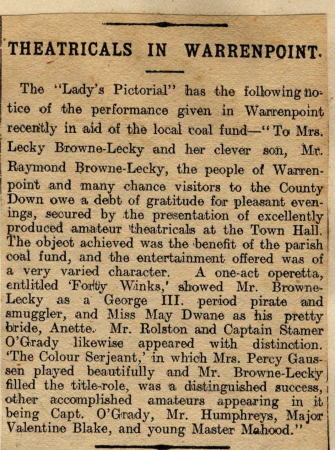
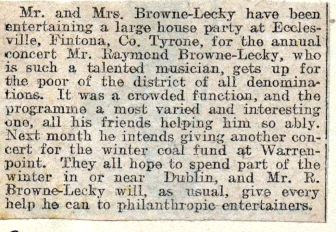
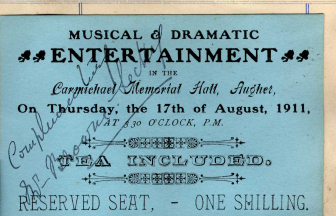
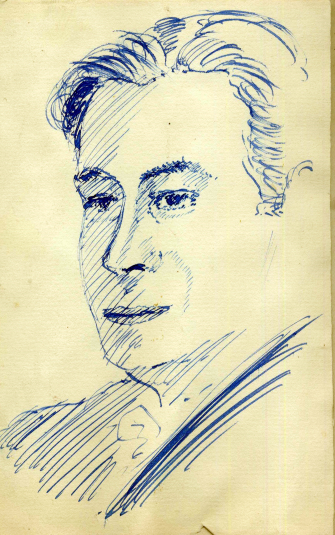
IRISH LIFE
On Tuesday, November 25th, most excellent amateur theatricals were given by Mr. Raymond Browne-Lecky in Fivemiletown, Co. Tyrone. “The Ghost,” a play in one act, by Charles Pender, and “Her New Dressmaker” being the plays presented. In the former piece Mr. Raymond Browne-Lecky appeared as the ambitious would-be Member of Parliament, “Horace Overend,” and scored a distinct success. Miss Margaret Waring made a very charming “Ethel Desmond,” and acted throughout with great judgement, she wore a most becoming dress of grey and white ninon, the skirt draped “en Panier,” swathed in “ciel” blue satin and a very attractive black velvet hat. Mr Cristie made quite a “hit” as “Frank Wakeley,” and won great applause for his finished rendering of by no means an easy part. Mr. Wilson Guy deserves special praise for his excellent rendering of the part of “Peter” (an old servant), which was most admirably played. In the sketch, “Her New Dressmaker,” Mr. Raymond Browne-Lecky fairly brought down the “house,” appearing in the role of a young widow, “Mrs. Forbes,” his “make-up” and disguise being so perfect that many of the audience were completely mystified, and refused to believe that the charming lady was, after all only a “mere man.” Mr. Raymond Browne-Lecky’s gown was as follows:- The “jupe” very full, “en cloche” draped with a “Volant” of “point d’Alencon” ; the “corsage” in “crepe de chine,” encircled with a “cincture of passementerie,” “manches en gigot,” veiled with a “Volant de dentelle,” the Rev. J. Hunter was equally successful, and played his part splendidly; both actors received quite an ovation at the fall of the curtain.
XMAS NUMBER 1913.
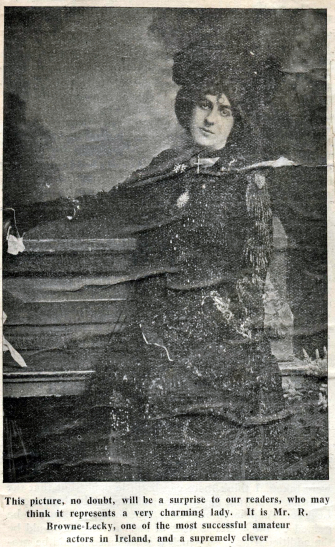
Anecdote: The Ghost at Ecclesville
(from The Figure in the Cave, by John Montague & Antoinette Quinn, Syracuse University Press, 1989)
Among the many stories that linger around Ecclesville, the ancestral home of the Browne-Lecky family, one stands out both for its humour and its theatrical flair—befitting the character of Raymond Browne-Lecky himself.
During the Second World War, part of the house had been requisitioned by American military officers, much to the discomfort of its ageing owner. “Old Browne-Lecky,” as he was affectionately known, viewed these uninvited guests with a blend of scepticism and aristocratic disdain. But it was not merely his own sensibilities that were offended—apparently, even the resident ghost had her limits.
As Raymond recounted in his “quavering voice,” the officers’ poor manners had disturbed his long-deceased great-aunt, who was said to conduct a nightly tour of the Georgian mansion. One night, while gliding along her usual route, she was startled to find herself challenged by a sentry. The unfortunate man, uncertain how to react to the ethereal figure moving silently through the corridor, fired his weapon straight through her.
Unshaken, the spectral lady turned, retraced her steps, and—in what Raymond described with full dramatic flourish—admonished the young soldier with ghostly indignation:
“Young man,” she said, waving a fleshless finger,
“whoever you are, and wherever you are from,
you have no savoir faire.
One simply does not fire on anyone,
especially a lady,
and especially dead,
in their own home.”
A tale that blends wit, class, and a trace of the supernatural, it speaks not only to Raymond’s vivid storytelling as “an actor of the old school,” but also to the enduring mystique of Ecclesville itself.
Portrait of a Character: Raymond Saville Conolly de Montmorency Lecky Browne-Lecky of Ecclesville
Raymond Browne-Lecky, heir to the Ecclesville estate and its final private owner, is remembered less for public office than for his theatrical flair, quick wit, and love of performance. His life spanned the twilight of the Irish Ascendancy, and the eccentricities of his personality captured the attention of contemporaries and biographers alike.
A Flair for Drama and Charity
A passionate amateur actor and producer, Raymond channelled his talents into fundraising for charitable causes. From 1909 to 1920, he organised concerts and dramatic performances to aid a variety of initiatives. Newspaper accounts from the time record his enthusiastic involvement in:
-
“Annual concert for the poor of the town of Fintona” (Irish Society, Sept 1910)
-
“Concert for the winter coal fund at Warrenpoint” (Irish Independent, Oct 1910)
-
“Concert for the Women’s Health Association” (Tyrone Constitution, Sept 1911)
-
Events in support of the Titanic disaster relief fund (1912) and the Soldiers’ and Sailors’ Families Association (1914)
One notable event was held on 9 March 1914 at the Abbey Theatre, Dublin, under the patronage of the Duke and Duchess of Abercorn, with proceeds going to the poor of Fintona. Though Raymond was too ill to perform that evening, the event was a great success:
“The attendance at the Abbey Theatre on Monday night must have established a record... Mr. Raymond Browne-Lecky may well feel proud of his success as promoter of the entertainment.”
— Irish Times, 1914
“Rather Amateurish, Don’t You Think?”
(Mark Bence-Jones, Twilight of the Ascendancy, Constable, 1987)
Bence-Jones recounts a characteristically dramatic episode from the 1960s, when Raymond—by then nearly eighty and nicknamed “Tibby”—hosted a genteel tea party. Among the guests was Miss Helen Bonaparte Wyse, a Waterford Ascendancy spinster descended from Lucien Bonaparte.
After tea, Miss Wyse returned from her car with a suitcase containing sheaves of Napoleonic verse and a Napoleon hat. She proceeded to give lengthy, impassioned recitations about Austerlitz, Jena, the Grande Armée, and the retreat from Moscow, all of her own composition.
Raymond, clad in a mauve velvet jacket, shifted uncomfortably. Unable to stand being upstaged in his own drawing room, he turned to a male guest and muttered in his high-pitched voice:
“Rather amateurish, don’t you think?”
Undeterred, Miss Wyse followed her dramatic readings with a thunderous piano performance of Rachmaninoff. Raymond, still sulking:
“Rather amateurish, don’t you think?”
Missteps in Biography
Bence-Jones also incorrectly claimed that Raymond's mother dressed him as a girl beyond the age this was customary, supposedly due to a longing for a daughter. In fact, Raymond was born in 1881 as the second child of Conolly William Lecky Browne-Lecky and Annie Browne-Lecky. His older sister, Isabella Caroline Annie, had been born in 1879, clearly disproving the suggestion that he was a substitute daughter.
Similarly, Ann Morrow, in Picnic in a Foreign Land (1990), wrote that Raymond “became a resident in his own home” after Ecclesville became a nursing home. This, too, is incorrect. Ecclesville did not become a care home until after Raymond’s death, and by that time, it had already been leased out. Raymond remained the private owner and occupant of Ecclesville until the end of his life.
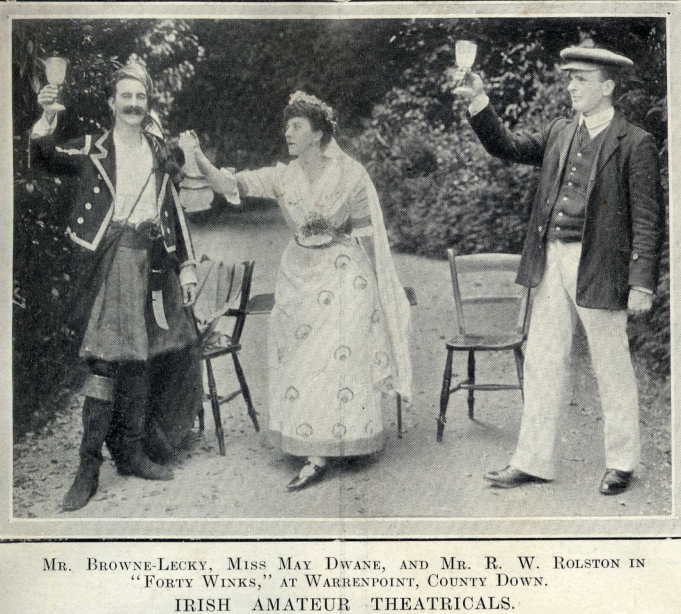
Raymond Browne-Lecky: A Candid Portrait from Irish Society and Social Review, 28 May 1921
"Mrs. Lecky Browne-Lecky, who was ill all the late winter and early spring of this year, is recuperating well at her northern residence, ‘Ecclesville,’ Co. Tyrone. The place belonged to her father and is quite a landmark in the country. The large entrance gates are situated at a crossroads not far from Fintona station, and all the country round — covering an immense district — has been Eccles property for centuries.
Both church and chapel are on the estate, built by the impartial owner whose beautiful memorial window adorns the chancel of Fintona Parish Church. It was erected by his daughter, the present occupant of Ecclesville."
The article opens with a reference to Annie Henrietta Browne-Lecky, Raymond’s mother, and the long-standing association of the Ecclesville estate with the Eccles family — from whom the Browne-Leckys descended through the female line.
"Wonderful paintings and objects of art the spacious old house contains, and guests, who are freely invited in the summer, find plenty of pleasant occupation exploring the stately rooms and the quaint old corridors — in some of the latter of which the kindly lady now recovering from illness took horse exercise in wet weather when a girl.
There is a private theatre in the western wing of the mansion, and amateur performances given there afford endless pleasure for visitors. Some magnificent copper beeches, declared by experts to be the finest in the Kingdom, adorn the front sweep of the expansive lawn. The main avenue to the gates is through double hedges of rhododendrons — glorious in crimson and purple colourings — and blossoming late, as do most growths in the far districts of the North."
This passage vividly illustrates the grandeur and charm of Ecclesville, capturing both its aesthetic elegance and eccentric personality — a suitable stage for Raymond himself.
"Mr. Raymond Browne-Lecky, the ‘actor-musician,’ as he is called, has his own special sanctum fitted up in graded shades of rose-pink — everything in exact harmony and tastefully selected. It is the only modern room in the house. The electric lighting circuits the lofty ceiling and shines through an ornamental cornice; photographs of friends, many of them prominent actors and singers, are freely skirted over the mantelpiece and tables, and the semi-grand Bechstein piano is draped with rose-coloured satin, embroidered in gay-plumaged birds."
This account, likely viewed as flamboyant at the time, is also deeply affectionate — acknowledging Raymond’s refined aesthetic tastes and connection to the theatrical world. His room, furnished in pink, symbolises both artistic flair and perhaps a gentle subversion of Edwardian masculine norms.
"From this home of sterling luxury, Mr. Raymond Browne-Lecky went out during the most anxious years of the war, utilising his own car and enduring many hardships while he toured the northern towns giving attractive entertainments for the benefit of the Red Cross. Not knowing, nor caring, where he might find night accommodation — giving no thought to where he lodged, what he ate, or how he was rained upon and blown — so long as his helpers were accommodated, he worked untiringly for the cause which he could not help by soldiering, because he failed to pass the health examination."
Despite being declared unfit for military service, Raymond devoted himself to wartime fundraising with quiet tenacity. This was especially notable in the conservative, martial values of post-Victorian British and Irish society, where non-enlistment could lead to social suspicion.
"How few in great cities knew, or know, anything of this devotional sacrifice. It was not paraded. People spoke, and still speak, of this wonderful man as ‘effeminate,’ and say how surprising it is that he did not join up and win distinctions. Such critics do not know anything at all, and what the man criticised thinks of his dissectors is never revealed through the happy smile with which he greets friends, and others, alike."
This closing statement is remarkable for its compassion and progressive tone. The article implicitly challenges gender and wartime stereotypes, presenting Raymond as both quietly heroic and graciously indifferent to judgment. That he allowed such a portrait to be published—in his lifetime, in 1921—shows real courage and self-possession.
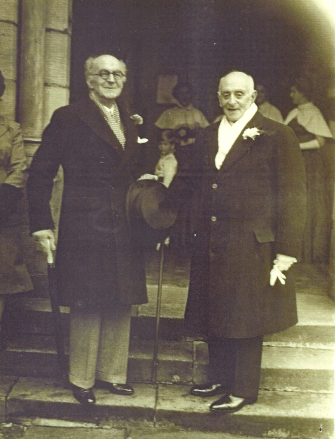
Raymond Saville Conolly de Montmorency Lecky Browne-Lecky and his partner Joel Henry Hart were present at the wedding of Celeste Ray and Nigel Mathew, which took place on 17th November 1951 at St. Columba’s Parish Church, Omagh. The reception was held at Ecclesville House, the ancestral home of the Browne-Lecky family.
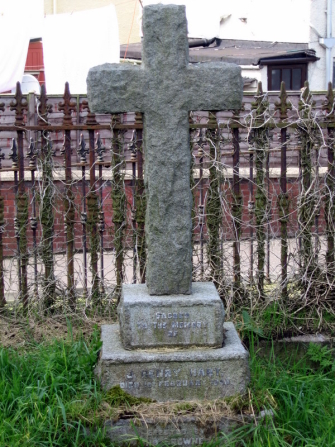
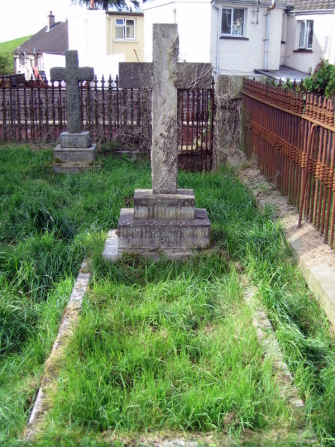
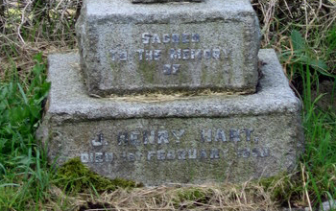
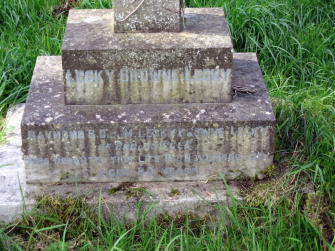
Raymond Saville Conolly de Montmorency Lecky Browne-Lecky died on 11th November 1961, Remembrance Day, aged 80. He was buried in the Castletown graveyard, near Fintona, County Tyrone, in a plot adjoining that of his long-time partner, Joel Henry Hart, who had died on 1st February 1953, aged 84, and was interred in the Eccles family lair.
Raymond and Joel had shared decades of companionship, and their burial arrangements — side by side in the family plot — offer a quiet but deeply personal testament to their enduring bond.
In his will, Raymond made specific provision for the future of his beloved family seat, Ecclesville. He directed that the property be:
It was Raymond’s hope that the Government would convert Ecclesville House into a nursing home, a common fate for many large country houses of the gentry in the post-war period. However, by the 1960s, such conversions had become prohibitively expensive, and the Government declined to proceed. Instead, the property was advertised to let, and was eventually leased to a lady from Belfast, who operated it as a nursing home for several years.
By 1978, the house was deemed surplus to requirements and was subsequently demolished, bringing to an end the long and distinguished chapter of Ecclesville House in the history of County Tyrone.
Funeral of Late
Mr. Raymond Browne-Lecky
There were most impressive scenes at the funeral on Wednesday afternoon of last week of Mr. Raymond de M, Browne-Lecky, of Ecclesville, Fintona, when the remains were interred in Fintona old graveyard. It is understood that this will be the last burial in this ancient ground, and it is most appropriate because no one could have shown a more practical interest in Fintona and district than Mr. Browne-Lecky during his whole lifetime.
The body had been resting in Donacavey parish Church, and as might be expected there was a large and representative attendance.
The impressive service with full choir, was conducted by the rector, Canon F.W.C Whitcroft, and Rt Rev. Dr. A.A. Buchanan, Bishop of Clogher, who came specially from Dublin, paid a glowing tribute to the deceased gentleman
He said Raymond Browne-Lecky died on 11th November, on the eve of Remembrance Sunday. It was a significant date because Sunday was the day they had set aside to pay tribute to the dead of two world wars. It was his custom to join them in their remembrance, and he was a benefactor to and a great supporter of the British Legion and ex-servicemen commenced during the First World War. He had been told by a friend in Dublin he recollected Mr. Browne-Lecky organising a concert for the troops in the year 1917 in a theatre in Dublin. That enthusiasm never waned and he was a staunch friend of ex-servicemen. He was proud of his native Fintona and took a keen interest in the community.
They had sung Mr. Browne-Lecky’s favourite hymn: “Take up thy cross the saviour said,” and that indicated his outlook on life. The Bishop spoke of Mr. Browne-Lecky's steadfastness, and said he set a grand example? For all to follow.
He would be greatly missed in Fintona and district.
The body was carried from the church by members of the select vestry, and Mr. Richard Scott presided at the organ. The coffin was carried into the graveyard by members of the British Legion and the service at the graveside was conducted by the Bishop, assisted by the Rector. Mr. Lewis Anderson carried a wreath from the parishioners, and Capt. R. A. Chambers, M.C. carried a wreath from the Fintona British Legion. There were many other floral tributes.
Amongst those observed at the funeral were Mrs. Mervyn Knox-Browne; Mrs. Anketell Moutray; the Earl of Caledon; Capt, peter Montgomery, D.L..; Capt. W. Maddin Scott Mr. H.M. Pollock; Col. C.R. McCausland; Dr. J. Chambers; Mr. Jan Pick; Mr. E.C.W. Baker; Capt. Marcus B. Lendrum; Mrs. J. F. Dickie; Mrs. De la Ray; Capt. B. and Mrs. White, Mr. Roy B. Holmes; Mrs. Sproule, with of course a large representation of the business and professional life of Fintona and district. Mr. Richard Holmes of London, a very old friend of the late Mr. Browne-Lecky, was prevented from attending the funeral but was represented by Capt. Sproule. [sic]
The Fate of the Ecclesville Portraits and the Lost McClintock Painting
Moira Douglas, writing for the Belfast Telegraph, offered a revealing glimpse into the final years of Ecclesville House and the fate of some of its contents. In her interview, she recorded:
“Mrs. May Knox-Browne, widow of Mr. Mervyn Knox-Browne of Aughentaine Castle, who has been living at Ecclesville for the past five or six years. It was Mrs. Knox-Browne who told me about the beautiful Amy Eccles, who sold her family home to her uncle by marriage, a Lecky-Browne-Lecky. Amy’s portrait hangs in the music room. She married a McClintock and went to live at nearby Seskinore. ‘A wonderful girl. Very rich – and she spent the lot.’”
The portrait referred to — of Mrs. Amy Henrietta McClintock (née Eccles) — was specifically bequeathed by Raymond Saville Conolly de Montmorency Lecky Browne-Lecky in his will:
"To hand over to the Dean and Chapter of Londonderry Cathedral all my family portraits (except the portrait of Mrs. McClintock which I hereby bequeath to her granddaughter who is my second cousin, Xeina Johnstone Wreeford [sic], my watch in double case, my clock in dining room, the china box in drawing room which formerly belonged to Napoleon, my silver Irish potato ring and my William and Mary tankard, also my musical box and my gold-headed stick. I direct that the decision as to what portraits are within the above description shall be at the absolute discretion of my Trustees and that the receipt of the Dean for the said articles shall be a good discharge to my Executors."
The name of the legatee was misspelled in the will. It should have read Xenia Joynson Wreford, who at the time was living in India. Sadly, the portrait never reached her. It is believed that she may not have been informed of the bequest by her guardian, Sheila Boteler, or perhaps the trustees were unable to trace her.
Despite the will’s clear instruction, the portrait was still hanging in the music room at Ecclesville when Moira Douglas visited and interviewed Mrs. Knox-Browne. It was not delivered to Xenia.
In June 2008, Xenia Joynson Wreford visited Mervyn Knox-Browne and his daughter Deirdre Yellowlees at Mervyn’s home in Perthshire. Mervyn recalled that he believed his mother had removed the portrait from Ecclesville before the auction, and was confident it was among her stored belongings. Deirdre, however, disagreed.
There is further evidence suggesting that the portrait had once been at Seskinore, the McClintock family home. An insurance inventory taken by Gallows of London in December 1914 (ref: D1716/19) lists:
“Oil painting: Portrait of Mrs. A. H. McClintock, 30in by 25in, by Costa – in heavy Florentine frame, valued at £40.”
A photograph of the hall at Seskinore shows a portrait of Col. J. K. McClintock on one wall and, reflected in a mirror above the chimney-piece, another portrait — in a heavy Florentine frame — which is strongly believed to be that of Mrs. McClintock. If so, the painting was attributed to Costa — most likely John da Costa.
As for the remaining family portraits, Londonderry Cathedral confirmed that the artworks bequeathed to them by Raymond were sold on the advice of John Morgan of John Ross & Co., Belfast. The Dean and Chapter received £778.15.0 for the sale in 1962, but unfortunately, the portraits were not listed in the published sale catalogue, which had already gone to print. Thus, no definitive record survives of which paintings were auctioned.
The public auction of Raymond’s personal possessions and house contents took place at Ecclesville on 2nd and 3rd February 1962, and fetched £23,500 over two days — a record sale at the time.
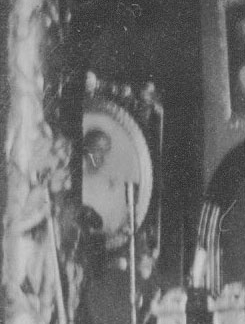
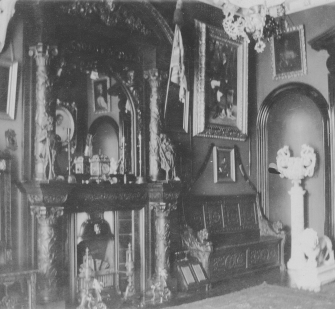
Portrait of Mrs. McClintock (Amy Eccles) in the Hall at Seskinore House
-
A historic photograph of the hall at Seskinore, the McClintock family residence near Fintona, County Tyrone, shows two key portraits:
-
One of Colonel J.K. McClintock, Amy’s husband, hanging directly on the wall.
-
Reflected in a mirror above the chimney-piece is a second portrait, in a heavy Florentine frame — believed to be a portrait of Amy McClintock (née Eccles).
-
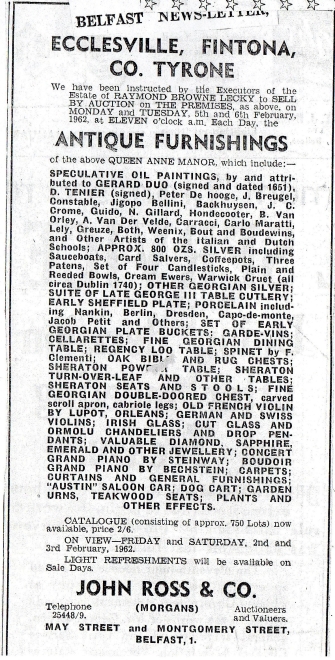
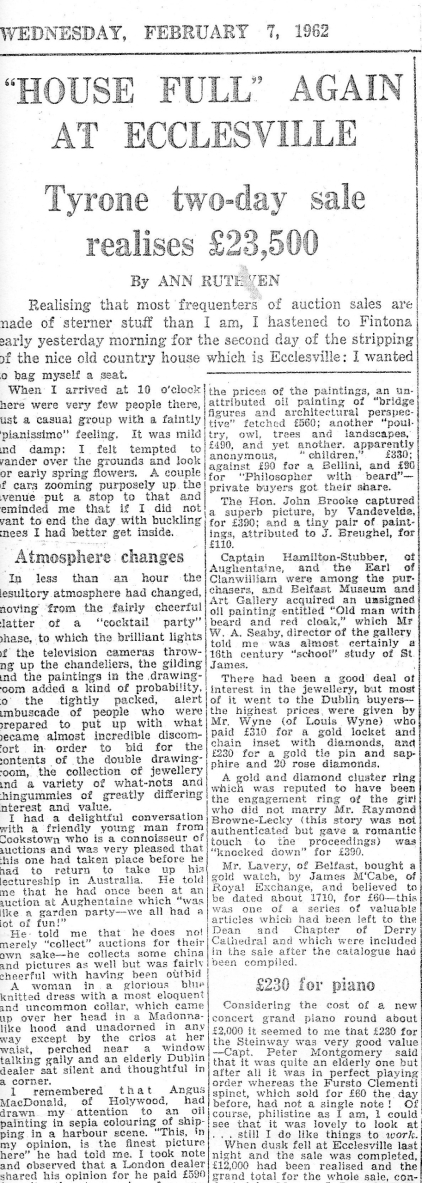
UNPRECEDENTED AUCTION SALE AT ECCLESVILLE FINTONA
(February 1962)
Buyers from London and Two Continents
The two-day auction of the effects of the late Mr. Raymond Browne-Lecky, at his residence, Ecclesville, Fintona, attracted buyers from as far apart as the United States, the Continent, London, Dublin and Belfast, and it is understood that the total realised in excess of £25,000.
The auction revealed that Ecclesville was a veritable Aladdin’s cave, In addition to valuable oil paintings by such famous artists as Gerard Dou, Constable, Tenier, and Breughal, Mr Browne-Lecky’s collection of jewellery attracted the attention of dealers.
Highest price for a picture was £560 for an unattributed oil of “Bridge, figures and architectural perspective,” Another “Poultry, owl, bees and landscapes” realised £490, and another “unknown artist” “children” fetched £330. While the astute dealers were snapping up these pictures, private buyers got a fair proportion, and one secured an attractive looking oil at £2-10-0.
An oil entitled “Old man with beard and red cloak,” was purchased for Belfast Museum. Capt. The Hon. John Brooke paid £390 for a picture by Van de Velde.
£460 was paid for a Queen Anne Silver Irish Tankard made in Dublin in 1760 by Joseph Walker, but it is understood it is not the property of the late Mr. Browne-Lecky.
An English dealer paid £410 for a pair of silver candlesticks, made by W. Walsh in Dublin. A set of three early Georgian mahogany male and female plate stands and receptacle container also realised £510. a set of Georgian reeded mahogany economy serving tables fetched £170, and a selection of silver sauceboats £250.
King William III
A half-length oil portrait of William III, attributed to Sir Peter Lely was bought by a Northern Ireland dealer at £160.
Jewellery
Most of the jewellery was picked by the Dublin dealers, and the best prices were given by Louis Wyne who paid £310 for a gold locket and chain inset with diamonds, and £230 for a gold tie-pin and sapphire and 20 rose diamonds, and another tie-pin set with garnets and a 11/2 carat diamond went for £145. A George III spade guinea sold at £30.
£460 FOR VIOLIN
Mr. Browne-Lecky’s favourite violin, made in 1780 by N. Lupot of Orleans, was bought by Mrs. Greenwood-Gant, better known as Valerie Trimble, the gifted Enniskillen pianist at £460, It is understood that she bought it for her daughter Caroline, aged 11.
The concert grand piano by Steinway was purchased for £230 and it was regarded as one of the “bargain buys.”
Mr. Browne-Lecky’s so well known 1937 Austin saloon car was bought at £40 by a Londonderry motor firm, who it is believed sold the car as new to Mr. Browne-Lecky twenty-five years ago. It was possibly the first two-tone car seen in Tyrone.
Generally there was very keen competition for most of the lots, and so great were the crowds of sightseers as well as buyers that many people found great difficulty in getting into the house. Several ladies, keen on getting bargains, clambered through the windows.
AUCTIONEERS HAVE MANY OMAGH FRIENDS
The auctioneers of the Ecclesville property, Messrs. Morgan Brothers, Belfast, made the Royal Arms Hotel their headquarters., Incidentally both these gentlemen served as officers in Omagh during the war and they have many friends locally.
In connection with the sales, the Royal Arms register carried some unusual names, e.g. Spellman, Sabin, Tooth, Kaitzer.
At the Melville Hotel, too, there were some well know antique dealers as well as a number of private buyers, mostly from Dublin.[sic]
ECCLESVILLE - AUCTION - FINE ART - SALE - 5-6th February 1962
(MAIN HALL)
- 39 Pair of interesting oil paintings “River & landscape,” by J.C. Crome, 33 ins x 27 ins., in moulded gilt frames (Originally in Aughentane Castle)
- 40 Gallery oil painting-“Allegorical scene, with figures and river,” 64 ins x 48 ins., in moulded gilt frame.
- 41 Three –quarter-length oil painting – “Monk at Prayer,” attributed to Guido, 37 ins x 27 ins., in moulded gilt frame.
- 42 Oil painting – “Classical columns, figures and ships,” 20 ins x 25ins., in moulded gilt frame.
- 43 Oil painting – “Dogs with game,” by N. Gillard, 331/2 ins x 42 ins., in moulded gilt frame.
(DINING ROOM)
- 208 French Musical Box in Ebonised and Gilt Case, painted panels of cupids and mermaids, inset fine Water colour of Paris, circa 1780.
- 209 Fine oil painting-“Equestrian figures with classical landscape background,” 28 ins x 25 ins., in moulded gilt frame (English school).
- 210 Fine oil painting – “River, Bridge and classical architecture, with figures,” 53 ins x 71 ins., in moulded gilt frame (Italian school).
- 211 Oil painting – “Hound and swan in combat,” attributed to Snyders, 39 ins x 51 ins, in moulded gilt frame.
- 212 Interesting gallery oil painting – Harbour scene, with classical architectural background,” 88 ins x 63 ins., in moulded gilt frame.
- 213 Half-length oil portrait – “William III,” attributed to Sir Peter Lely, 23 ins x 28 ins., in moulded gilt frame.
- 214 Oil painting – “Swans and ducks,” by Hondecooter, 58 ins x 43 ins., in black moulded frame.
- 215 Three-quarter-length oil portrait – “Boy with Dog,” 24 ins x 29 ins., in moulded gilt frame.
- 216 Oil painting – “Classical buildings, River and figures,” 36 ins x 51 ins., in moulded gilt frame.
- 217 Oil painting – “Stag at Bay,” (signed), 49 ins x 29 ins., in moulded gilt frame.
(PASSAGE TO DRAWING & MUSIC ROOMS)
- 249 Oil painting—“Salmon,” 30 ins. X 16 ins., in moulded gilt frame.
- 250 Oil painting—“Shipping at sunset,” by Moltino, 63 ins. X 35 ins., in moulded gilt frame.
- 251 Oil painting—“Salmon,” by H.L.Rolfe, 171/2 ins. X 111/2 ins., inmoulded gilt frame.
- 252 Two Oil paintings—“Salmon” by H.L Rolfe, 29 ins. X 19 ins., in moulded gilt frame.
(MUSIC ROOM)
- 280 Three-Quarter-Length Water colour Portrait “Lady, with black lace shawl,” 18 ins. X 13 1/2ins., in moulded gilt frame.
- 285 Coloured Print—“The Dresden Beauty,” 131/2 ins. X 9 ins., in moulded gilt frame, and Two framed Music covers.
- 288 Three-Quarter-Length Oil Portrait – “Gentleman with cravat, holding eyeglass,” 14 ins. X 11ins., in moulded gilt frame.
- 298 Woolwork Picture—“Flowers,” and Coloured Print “Field Marshal, Sir Henry Wilson.”
- 299 Half-Length Oil Portrait—“Officer in red and green jacket,” on copper panel, 51/2 ins. X 41/2 ins., in moulded gilt frame.
- 300 Silk Needlework Picture—“Ship Wreck,” 101/2 ins. X 10 ins.. in moulded gilt frame.
- 302 Very Interesting Dutch Oil Painting on Panel – “Woman holding Game Bird, with figures, drapery and vegetables,” by Gerard Dou, signed and dated 1651, 12 ins. X 10 ins., in moulded gilt frame.
- 303 Oil Painting – Virgin Mary,” attributed to Carlo Dolci, 12 ins. X 9 ins., in moulded gilt frame.
- 313 Interesting Oil Painting –“Christ with Mary Magdalene after the Resurrection,” on cradled canvas, by B. Van Orley, 23 ins. X 17 ins., in moulded gilt frame.
- 324 Oil painting –“Young Girl with striped bodice, carrying basket with flowers,” 29 ins. X 22 ins. In Florentine gilt frame.
- 338 Oil Painting—“Girl,” attributed to Greuze, 171/2 ins. X 141/2 ins., in gilt frame.
- 339 Half-Length Miniature on Ivory of Young Girl, 31/2 ins. 23/4 ins., in moulded gilt frame.
- 341 Oil Painting –“Dutch Interior,” attributed to Peter De Hooge, 18 ins. X 23 ins., in moulded gilt frame.
- 343 Interesting Oil Painting –“Biblical Scene,” attributed to Carracci, 24 ins. X 181/2 ins., in moulded gilt frame.
(DRAWING ROOM)
- 484 Interesting Oval Oil Painting—“The Veil of St Veronica,” on copper panel, attributed to Carlo Maratti, 6 ins. X 41/2 ins., in moulded gilt frame.
- 485 Oil Painting—“Sunset and landscape,” 81/2 ins. X 13 ins., in moulded gilt frame.
- 486 Oil Painting – “Cattle, Figures and Landscape,” by A. Vandevelde, 30 ins. X 40 ins., in carved wood and gilt openwork frame.
- 487 Interesting Oil Painting – “Biblical Scene, with classical architecture and figures,” on copper panel, 131/2 ins. X 111/2 ins., in moulded gilt frame.
- 488 Oil Painting—“Fox and Landscape,” in moulded gilt frame, 16 ins. X 111/2 ins.
- 489 Oil Painting—“Classical Architecture and Figures,” 49 ins. X 59 ins., in moulded gilt frame.
- 490 Oil Painting—“Still Life, Stag’s Head and Game,” attributed to Weenix, 241/2 ins. X 301/2 ins. In moulded gilt frame.
- 491 Pair of Interesting Oval Oil Paintings—“Fishermen, Landscape, Castle Figures and Classical Architecture,” attributed to J. Breughel, on panel 41/2 ins. X 6 ins., in moulded gilt frame.
- 492 Oil Painting—“Rural scene with trees, cottage, figures and sheep,” signed J. Constable, 111/2 ins. X 9 ins., in moulded gilt frame.
- 493 Interesting Oil Painting—“Interior, with seated and Drinking Figures,” by D. Tenier, 61/2 ins. X 9 ins., in moulded gilt frame (signed).
- 494 Interesting Oil painting on Panel – “Girl in Red Coat,” attributed to Metzu, 12 ins. X 9 ins., in moulded gilt frame.
- 495 Oil Painting—“Children,” 24 ins. X 29 ins., in moulded gilt frame.
- 496 Oil Painting—“Dutch Scene,” in style of Tenier, 11 ins. X 141/2 ins., in carved and moulded gilt frame.
- 497 Oil painting—“Shepherd Boy,” 211/2 ins. X 151/2 ins., in moulded gilt frame.
- 498 Pair of Oil paintings on Panels—“Shrimp Gatherers,” by M. Day, 51/2 ins. X 12 ins., in moulded gilt frame.
- 499 Pair of Interesting Oil paintings on Panels—“River, Figures, Trees and Landscape,” attributed to J. Breughel, 81/2 ins. X 41/2 ins., in moulded gilt frame.
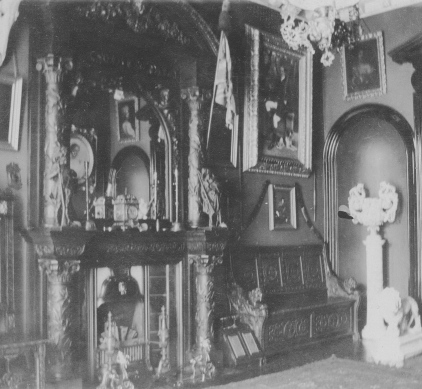
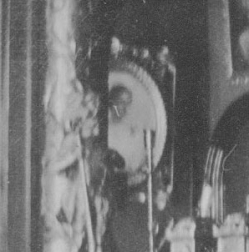
Gift Offer by Govt.
Gets Refused.
ECCLESVILLE, the 250- year - old haunted mansion in Co. Tyrone willed to the Government by its late owner, may turn out to be a headache for the authorities. But the problem is not the lady-in-silk ghost who reputedly flits from room to room.
The big question is: What will the Government do with the house?
This week the Ministry of Health and Local Government inquired if Tyrone Welfare Committee was interested in it for possible use as an old people's home. But the Committee decided it didn't want to be burdened with the upkeep of an old mansion and said
"No, thank you."
Said a Ministry of Finance spokesman: "We will have to see if anyone else is interested."
When he died last November 80-year-old bachelor. Mr. Raymond de M. Browne-Lecky, directed in his will that his land and mansion house at Fintona should be handed over to the Government or whatever public body the Government should nominate.
Conditions
But even though the Ministry offered the mansion to Tyrone Welfare Committee it seems that the Government doesn't actually own the mansion yet.
Said the solicitors handling the estate: "Ecclesville was willed to the Government for whatever purpose it could And—on certain conditions the Government had to comply with. The Ministry has given us no official Intimation that it has accepted it yet."
"Mr. Browne-Lecky had no family of his own and he possibly thought the Government might turn the place into an old people's home or something like that."
But nowadays Tyrone Welfare Committee prefers to build new homes.
"We are not anxious to take any more old buildings over and convert them," said Mr. A. P. Fields, County Welfare Officer.
"We were compelled to do that sort of thing in the early days when building was difficult. We took over one or two old houses, but there are repairs and upkeep to be considered. Nowadays we start from scratch."
"Anyway we have an old people's home at Clogher, 10 miles away, and we have a new one opening in Omagh this autumn."
And so, for the present, the phantom in silk has Ecclesville to herself.
Belfast Telegraph - Friday 23 February 1962
The Government could not find a use for the house and advertised it for let, eventually in 1978, it was decided that it was not required and the notice of application to demolish the house was published in The Belfast Gazette on the 1st Jan 1978.
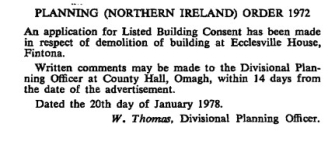
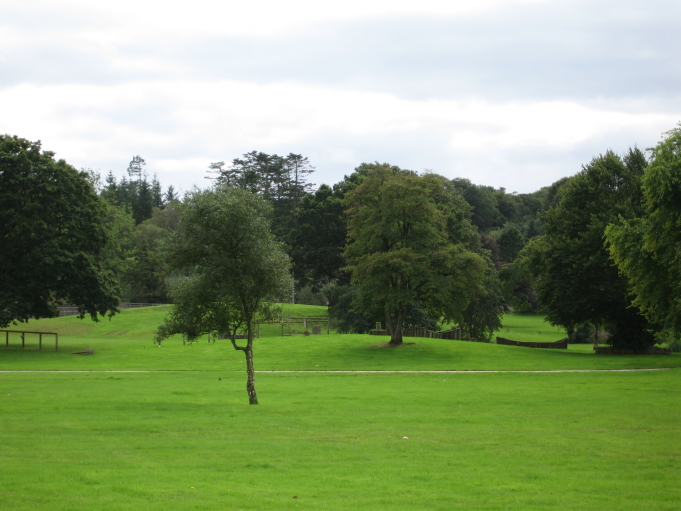
Site of Ecclesville House.
Raymond’s Charitable Legacy and the Fight to Uphold It
Beyond his deep love for Ecclesville and its history, Raymond Saville Conolly de Montmorency Lecky Browne-Lecky expressed a lasting commitment to the performing arts and music. In his will, following several personal bequests, he directed his Trustees:
“To hold all the remainder of my estate Upon Trust as to one half thereof for the Trustees of the Charity in aid of members of the theatrical profession now located at Denville Hall, Northwood, Middlesex, to be applied by them for the purposes of said Charity… and as to the remaining one half… Upon Trust for the Musicians Benevolent Fund, c/o St. Cecilia’s House, Carlos Place, London, W.1…”
These beneficiaries — the Actors' Charitable Trust (ACT) and the Musicians Benevolent Fund — inherited the residue of Raymond’s estate, which primarily consisted of ground rents and property interests in County Londonderry, inherited decades earlier by Raymond from his great-granduncle, Conolly McCausland Lecky.
For many years, both charities received annual payments from these properties. However, in 1993, the payments abruptly stopped. That same year, the legal title to the Londonderry properties was formally vested in the charities' names, but a key document was missing: the counterpart lease dated 4 February 1900, covering the last remaining income-producing property. Without this document, Londonderry City Council, which had been paying the ground rent since 1961, decided to cease all future payments.
In January 2006, I contacted both Robert Ashby of ACT and the Musicians Benevolent Fund, inquiring about the status of Raymond’s bequest. With their agreement and formal authorisation, I undertook an investigation into the estate’s management and unresolved income.
After several visits to PRONI and the Land Registry in Belfast, I was able to identify the trust’s residual property interests. Then, in 2010, the Musicians Benevolent Fund located the relevant file confirming my calculations — approximately £10,000 in unpaid ground rent had accrued since payments ceased in 1993.
The key obstacle remained the missing counterpart lease. But through a Freedom of Information (FOI) request submitted to Londonderry City Council, I successfully obtained a copy of the 1900 lease — the exact document that had been missing from the trust’s file.
However, even after receiving the lease, no one from the Council would engage on the matter, and the legal representatives appointed under Raymond’s will stated that it was “not worth pursuing.” The charities, wary of legal costs, chose not to take formal action.
The issue was no longer about the money: “It wasn’t that a great amount of money was at stake, but morally a matter of principle. The Council knew that they should have been paying the rent, but also knew that it was legally going to be prohibitive for the charities to pursue it.”
In August 2011, unwilling to let the matter go, I contacted Julie McCullough, a journalist with BBC Northern Ireland, who recognised its importance and agreed to investigate. Her work culminated in doorstepping Londonderry City Council, publicly confronting them over the non-payment. The resulting pressure led to success: the Council accepted responsibility, agreed to pay part of the withheld arrears, and resolved to resume ground rent payments to the charities going forward.
Julie’s BBC Newsline report aired in November 2011, almost exactly 50 years after Raymond’s death on 11 November 1961. Thanks to your efforts — and the power of investigative journalism — Raymond’s charitable legacy was finally honoured, and the support he had intended for actors and musicians was restored.
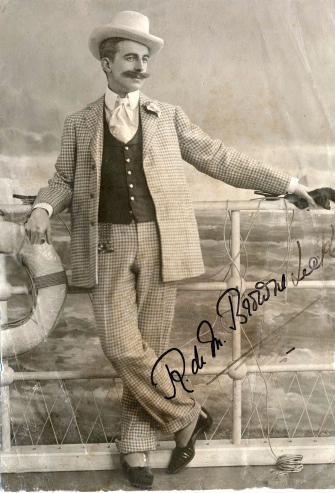
Images reproduced with kind permission from PRONI D1385/4
